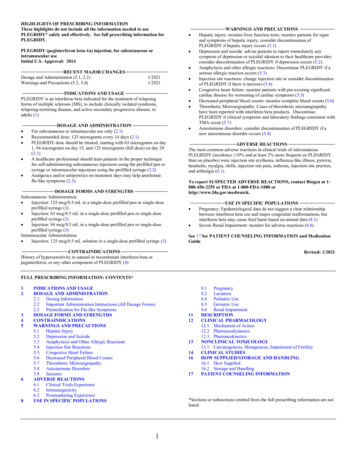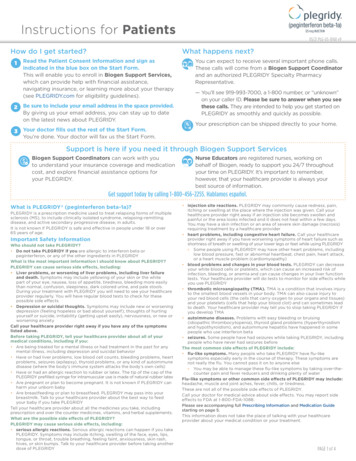
Transcription
HIGHLIGHTS OF PRESCRIBING INFORMATIONThese highlights do not include all the information needed to usePLEGRIDY safely and effectively. See full prescribing information forPLEGRIDY.PLEGRIDY (peginterferon beta-1a) injection, for subcutaneous orintramuscular useInitial U.S. Approval: 2014RECENT MAJOR CHANGESDosage and Administration (2.1, 2.2)1/2021Warnings and Precautions (5.3, 5.4)1/2021INDICATIONS AND USAGEPLEGRIDY is an interferon beta indicated for the treatment of relapsingforms of multiple sclerosis (MS), to include clinically isolated syndrome,relapsing-remitting disease, and active secondary progressive disease, inadults (1)DOSAGE AND ADMINISTRATION For subcutaneous or intramuscular use only (2.1)Recommended dose: 125 micrograms every 14 days (2.1)PLEGRIDY dose should be titrated, starting with 63 micrograms on day1, 94 micrograms on day 15, and 125 micrograms (full dose) on day 29(2.1)A healthcare professional should train patients in the proper techniquefor self-administering subcutaneous injections using the prefilled pen orsyringe or intramuscular injections using the prefilled syringe (2.2)Analgesics and/or antipyretics on treatment days may help ameliorateflu-like symptoms (2.3)DOSAGE FORMS AND STRENGTHSSubcutaneous Administration: Injection: 125 mcg/0.5 mL in a single-dose prefilled pen or single-doseprefilled syringe (3) Injection: 63 mcg/0.5 mL in a single-dose prefilled pen or single-doseprefilled syringe (3) Injection: 94 mcg/0.5 mL in a single-dose prefilled pen or single-doseprefilled syringe (3)Intramuscular Administration: Injection: 125 mcg/0.5 mL solution in a single-dose prefilled syringe (3)WARNINGS AND PRECAUTIONSHepatic injury: monitor liver function tests; monitor patients for signsand symptoms of hepatic injury; consider discontinuation ofPLEGRIDY if hepatic injury occurs (5.1) Depression and suicide: advise patients to report immediately anysymptom of depression or suicidal ideation to their healthcare provider;consider discontinuation of PLEGRIDY if depression occurs (5.2) Anaphylaxis and other allergic reactions: Discontinue PLEGRIDY if aserious allergic reaction occurs (5.3) Injection site reactions: change injection site or consider discontinuationof PLEGRIDY if there is necrosis (5.4) Congestive heart failure: monitor patients with pre-existing significantcardiac disease for worsening of cardiac symptoms (5.5) Decreased peripheral blood counts: monitor complete blood counts (5.6) Thrombotic Microangiopathy: Cases of thrombotic microangiopathyhave been reported with interferon beta products. DiscontinuePLEGRIDY if clinical symptoms and laboratory findings consistent withTMA occur (5.7) Autoimmune disorders: consider discontinuation of PLEGRIDY if anew autoimmune disorder occurs (5.8) ADVERSE REACTIONSThe most common adverse reactions in clinical trials of subcutaneousPLEGRIDY (incidence 10% and at least 2% more frequent on PLEGRIDYthan on placebo) were injection site erythema, influenza-like illness, pyrexia,headache, myalgia, chills, injection site pain, asthenia, injection site pruritus,and arthralgia (6.1)To report SUSPECTED ADVERSE REACTIONS, contact Biogen at 1800-456-2255 or FDA at 1-800-FDA-1088 orhttp://www.fda.gov/medwatch.USE IN SPECIFIC POPULATIONS Pregnancy: Epidemiological data do not suggest a clear relationshipbetween interferon beta use and major congenital malformations, butinterferon beta may cause fetal harm based on animal data (8.1) Severe Renal Impairment: monitor for adverse reactions (8.6)See 17 for PATIENT COUNSELING INFORMATION and MedicationGuideCONTRAINDICATIONSRevised: 1/2021History of hypersensitivity to natural or recombinant interferon beta orpeginterferon, or any other component of PLEGRIDY (4)FULL PRESCRIBING INFORMATION: CONTENTS*1234568INDICATIONS AND USAGEDOSAGE AND ADMINISTRATION2.1 Dosing Information2.2 Important Administration Instructions (All Dosage Forms)2.3 Premedication for Flu-like SymptomsDOSAGE FORMS AND STRENGTHSCONTRAINDICATIONSWARNINGS AND PRECAUTIONS5.1 Hepatic Injury5.2 Depression and Suicide5.3 Anaphylaxis and Other Allergic Reactions5.4 Injection Site Reactions5.5 Congestive Heart Failure5.6 Decreased Peripheral Blood Counts5.7 Thrombotic Microangiopathy5.8 Autoimmune Disorders5.9 SeizuresADVERSE REACTIONS6.1 Clinical Trials Experience6.2 Immunogenicity6.3 Postmarketing ExperienceUSE IN SPECIFIC POPULATIONS1112131416178.1 Pregnancy8.2 Lactation8.4 Pediatric Use8.5 Geriatric Use8.6 Renal ImpairmentDESCRIPTIONCLINICAL PHARMACOLOGY12.1 Mechanism of Action12.2 Pharmacodynamics12.3 PharmacokineticsNONCLINICAL TOXICOLOGY13.1 Carcinogenesis, Mutagenesis, Impairment of FertilityCLINICAL STUDIESHOW SUPPLIED/STORAGE AND HANDLING16.1 How Supplied16.2 Storage and HandlingPATIENT COUNSELING INFORMATION*Sections or subsections omitted from the full prescribing information are notlisted.1
FULL PRESCRIBING INFORMATION1INDICATIONS AND USAGEPLEGRIDY is indicated for the treatment of relapsing forms of multiple sclerosis (MS), toinclude clinically isolated syndrome, relapsing-remitting disease, and active secondaryprogressive disease, in adults.2DOSAGE AND ADMINISTRATION2.1Dosing InformationPLEGRIDY may only be administered subcutaneously (SC) or intramuscularly (IM).Recommended Maintenance DosageAfter initial titration (see Table 1 and Table 2), the recommended dosage of PLEGRIDY is 125micrograms injected every 14 days.For subcutaneous injection:Patients may rotate injection sites between the abdomen, back of the upper arm, or thigh.For intramuscular injection:Patients may rotate injection sites between the left and right thighs.Treatment InitiationDose titration at the initiation of treatment may help to ameliorate flu-like symptoms that canoccur at treatment initiation with interferons. Prophylactic and concurrent use of analgesicsand/or antipyretics may prevent or ameliorate flu-like symptoms sometimes experienced duringtreatment with PLEGRIDY.Switching between the subcutaneous and intramuscular routes of administration and vice versahas not been studied. It is not expected that dose titration should be repeated to ameliorate flulike symptoms if switching between subcutaneous and intramuscular routes of administration, orvice versa based upon bioequivalence demonstrated between the two routes of administration.Subcutaneous Administration of PLEGRIDYPatients using PLEGRIDY for the first time should start treatment with 63 micrograms on day 1.On day 15 (14 days later), the dose is increased to 94 micrograms, reaching the full dose of 125micrograms on day 29 (after another 14 days). Patients continue with the full dose (125micrograms) every 14 days thereafter (see Table 1). A PLEGRIDY Starter Pack is availablecontaining two prefilled pens or syringes: 63 micrograms (dose 1) and 94 micrograms (dose 2).Table 1:Schedule for Subcutaneous Dose TitrationDoseTimeaAmount (micrograms)Color of Pen orSyringe LabelDose 1On day 163Orange2
aDoseTimeaAmount (micrograms)Color of Pen orSyringe LabelDose 2On day 1594BlueDose 3On day 29 and every 14days thereafter125 (full dose)GreyDosed every 14 daysIntramuscular Administration of PLEGRIDYFor patients using PLEGRIDY injected intramuscularly for the first time, PLEGRIDY should betitrated using the PLEGRIDY Titration Kit designed for use with the prefilled syringe. ThePLEGRIDY Titration Kit is supplied separately and contains two titration devices to be usedonly with PLEGRIDY prefilled syringes for intramuscular use.Patients should start treatment with 63 micrograms (yellow clip) on day 1. On day 15 (14 dayslater), the dose is increased to 94 micrograms (purple clip), reaching the full dose of 125micrograms on day 29 (after another 14 days). Patients continue with the full dose (125micrograms) every 14 days thereafter (see Table 2).Table 2:DoseTimeaAmount (micrograms)Titration ClipDose 1On day 163YellowDose 2On day 1594PurpleDose 3On day 29 and every 14days thereafter125 (full dose)No Clips Neededa Dosed2.2Schedule for Intramuscular Dose Titrationevery 14 daysImportant Administration Instructions (All Dosage Forms)Healthcare professionals should train patients in the proper technique for self-administeringsubcutaneous injections using the prefilled pen or syringe or intramuscular injections using theprefilled syringe. Parenteral drug products should be inspected visually for particulate matter anddiscoloration prior to administration. Patients should be advised to rotate injection sites with eachadministration.Once removed from the refrigerator, PLEGRIDY should be allowed to warm to roomtemperature (about 30 minutes) prior to injection. Do not use external heat sources such as hotwater to warm PLEGRIDY.3
Each PLEGRIDY pen and syringe for subcutaneous injection is provided with the needle preattached. PLEGRIDY prefilled syringe for intramuscular injection is supplied as a prefilledsyringe with a separate needle. Both intramuscular and subcutaneous prefilled syringes andsubcutaneously administered prefilled pens are for one-time use in one patient only and shouldbe discarded after use.2.3Premedication for Flu-like SymptomsProphylactic and concurrent use of analgesics and/or antipyretics may prevent or ameliorate flulike symptoms sometimes experienced during treatment with PLEGRIDY.3DOSAGE FORMS AND STRENGTHSPLEGRIDY is a clear to slightly opalescent and colorless to slightly yellow solution.Subcutaneous Administration: Injection: 125 mcg/0.5 mL in a single-dose prefilled pen or single-dose prefilled syringe Injection: 63 mcg/0.5 mL in a single-dose prefilled pen or a single-dose prefilled syringe Injection: 94 mcg/0.5 mL in a single-dose prefilled pen or a single-dose prefilled syringeIntramuscular Administration: 4Injection: 125 mcg/0.5 mL in a single-dose prefilled syringeCONTRAINDICATIONSPLEGRIDY is contraindicated in patients with a history of hypersensitivity to natural orrecombinant interferon beta or peginterferon, or any other component of PLEGRIDY [seeWarnings and Precautions (5.3)].5WARNINGS AND PRECAUTIONS5.1Hepatic InjurySevere hepatic injury, including hepatitis, autoimmune hepatitis, and rare cases of severe hepaticfailure, have been reported with interferon beta. Asymptomatic elevation of hepatictransaminases has also been reported, and in some patients has recurred upon rechallenge withinterferon beta.Elevations in hepatic enzymes and hepatic injury have been observed with the use ofPLEGRIDY in clinical studies. The incidence of increases in hepatic transaminases was greaterin patients taking PLEGRIDY than in those taking placebo. The incidence of elevations ofalanine aminotransferase above 5 times the upper limit of normal was 1% in placebo-treatedpatients and 2% in PLEGRIDY-treated patients. The incidence of elevations of aspartateaminotransferase above 5 times the upper limit of normal was less than 1% in placebo-treatedpatients and less than 1% in PLEGRIDY-treated patients. Elevations of serum hepatic4
transaminases combined with elevated bilirubin occurred in 2 patients. Both cases resolvedfollowing discontinuation of PLEGRIDY.Monitor patients for signs and symptoms of hepatic injury.5.2Depression and SuicideDepression, suicidal ideation, and suicide occur more frequently in patients receiving interferonbeta than in patients receiving placebo.In clinical studies, the overall incidence of adverse events related to depression and suicidalideation in multiple sclerosis patients was 8% in both the PLEGRIDY and placebo groups. Theincidence of serious events related to depression and suicidal ideation was similar and less than1% in both groups.Advise patients to report immediately any symptom of depression or suicidal ideation to theirhealthcare provider. If a patient develops depression or other severe psychiatric symptoms,consider stopping treatment with PLEGRIDY.5.3Anaphylaxis and Other Allergic ReactionsSerious allergic reactions are rare complications of treatment with interferon beta; anaphylaxishas been reported with use of PLEGRIDY in the postmarketing setting.Less than 1% of PLEGRIDY-treated patients experienced a serious allergic reaction such asangioedema or urticaria. Those who did have serious allergic reactions recovered promptly aftertreatment with antihistamines or corticosteroids. Discontinue PLEGRIDY if a serious allergicreaction occurs.The protective rubber cover of the PLEGRIDY prefilled syringe for intramuscular administrationcontains natural rubber latex which may cause allergic reactions and should not be handled bylatex-sensitive individuals. The safe use of PLEGRIDY prefilled syringe in latex-sensitiveindividuals has not been studied.5.4Injection Site ReactionsInjection site reactions, including injection site necrosis, can occur with the use of interferonbeta.In clinical studies of subcutaneous PLEGRIDY, the incidence of injection site reactions (e.g.,injection site erythema, pain, pruritus, or edema) was 66% in the PLEGRIDY group and 11% inthe placebo group; the incidence of severe injection site reactions was 3% in the PLEGRIDYgroup and 0% in the placebo group. One patient out of 1468 patients who received PLEGRIDYin clinical studies experienced injection site necrosis. The injury resolved with standard medicaltreatment.In Study 3, which compared single doses of intramuscular and subcutaneous PLEGRIDY [seeAdverse Reactions (6.1)], the incidence of injection site reactions (e.g., injection site erythema,pain, pruritus, or edema) was 14% in the intramuscular PLEGRIDY group and 32% in thesubcutaneous PLEGRIDY group.5
Decisions to discontinue therapy following necrosis at a single injection site should be based onthe extent of the necrosis. For patients who continue therapy with PLEGRIDY after injectionsite necrosis has occurred, avoid administration of PLEGRIDY near the affected area until it isfully healed. If multiple lesions occur, discontinue PLEGRIDY until healing occurs.5.5Congestive Heart FailureCongestive heart failure, cardiomyopathy, and cardiomyopathy with congestive heart failureoccur in patients receiving interferon beta.In clinical studies, the incidence of cardiovascular events was 7% in both PLEGRIDY andplacebo treatment groups. No serious cardiovascular events were reported in the PLEGRIDYgroup.Monitor patients with significant cardiac disease for worsening of their cardiac condition duringinitiation and continuation of treatment with PLEGRIDY.5.6Decreased Peripheral Blood CountsInterferon beta can cause decreased peripheral blood counts in all cell lines, including rareinstances of pancytopenia and severe thrombocytopenia.In clinical studies, decreases in white blood cell counts below 3.0 x 109/L occurred in 7% ofpatients receiving PLEGRIDY and in 1% receiving placebo. There is no apparent associationbetween decreases in white blood cell counts and an increased risk of infections or seriousinfections. The incidence of clinically significant decreases in lymphocyte counts (below 0.5 x109/L), neutrophil counts (below 1.0 x 109/L), and platelet counts (below 100 x 109/L) were allless than 1% and similar in both placebo and PLEGRIDY groups. Two serious cases werereported in patients treated with PLEGRIDY: one patient (less than 1%) experienced severethrombocytopenia (defined as a platelet count less than or equal to 10 x 109/L), and anotherpatient (less than 1%) experienced severe neutropenia (defined as a neutrophil count less than orequal to 0.5 x 109/L). In both patients, cell counts recovered after discontinuation ofPLEGRIDY. Compared to placebo, there were no significant differences in red blood cell countsin patients treated with PLEGRIDY.Monitor patients for infections, bleeding, and symptoms of anemia. Monitor complete blood cellcounts, differential white blood cell counts, and platelet counts during treatment withPLEGRIDY. Patients with myelosuppression may require more intensive monitoring of bloodcell counts.5.7Thrombotic MicroangiopathyCases of thrombotic microangiopathy (TMA), including thrombotic thrombocytopenicpurpura and hemolytic uremic syndrome, some fatal, have been reported with interferonbeta products. Cases have been reported several weeks to years after starting interferonbeta products. Discontinue PLEGRIDY if clinical symptoms and laboratory findings consistentwith TMA occur, and manage as clinically indicated.6
5.8Autoimmune DisordersAutoimmune disorders of multiple target organs including idiopathic thrombocytopenia, hyperand hypothyroidism, and autoimmune hepatitis have been reported with interferon beta.In clinical studies, the incidence of autoimmune disorders was less than 1% in both PLEGRIDYand placebo treatment groups.If patients develop a new autoimmune disorder, consider stopping PLEGRIDY.5.9SeizuresSeizures are associated with the use of interferon beta.The incidence of seizures in multiple sclerosis clinical studies was less than 1% in patientsreceiving PLEGRIDY and placebo.Exercise caution when administering PLEGRIDY to patients with a seizure disorder.6ADVERSE REACTIONSThe following serious adverse reactions are discussed in more detail in other sections of labeling: Hepatic Injury [see Warnings and Precautions (5.1)] Depression and Suicide [see Warnings and Precautions (5.2)] Anaphylaxis and Other Allergic Reactions [see Warnings and Precautions (5.3)] Injection Site Reactions [see Warnings and Precautions (5.4)] Congestive Heart Failure [see Warnings and Precautions (Section 5.5 )] Decreased Peripheral Blood Counts [see Warnings and Precautions (5.6)] Thrombotic Microangiopathy [see Warnings and Precautions (5.7)] Autoimmune Disorders [see Warnings and Precautions (5.8)] Seizures [see Warnings and Precautions (5.9)]6.1Clinical Trials ExperienceBecause clinical trials are conducted under widely varying conditions, adverse reaction ratesobserved in the clinical trials of PLEGRIDY cannot be directly compared to rates in clinicaltrials of other drugs and may not reflect the rates observed in practice.PLEGRIDY Via Subcutaneous AdministrationIn clinical studies (Study 1 and Study 2), a total of 1468 patients with relapsing multiple sclerosisreceived PLEGRIDY by subcutaneous injection for up to 177 weeks (41 months), with anoverall exposure equivalent to 1932 person-years. A total of 1093 patients received at least 1year, and 415 patients at least 2 years of treatment with PLEGRIDY. A total of 512 and 500patients, respectively, received PLEGRIDY 125 micrograms every 14 days or every 28 days7
during the placebo-controlled phase of Study 1 (year 1). The experience in year 2 of Study 1 andin the 2-year safety extension study (Study 2) was consistent with the experience in the 1-yearplacebo-controlled phase of Study 1.In the placebo-controlled phase of Study 1, the most common adverse drug reactions forPLEGRIDY 125 micrograms subcutaneously every 14 days were injection site erythema,influenza-like illness, pyrexia, headache, myalgia, chills, injection site pain, asthenia, injectionsite pruritus, and arthralgia (all had incidence more than 10% and at least 2% more thanplacebo). The most commonly reported adverse event leading to discontinuation in patientstreated with PLEGRIDY 125 micrograms subcutaneously every 14 days was influenza-likeillness (in less than 1% of patients).Table 3 summarizes adverse reactions reported over 48 weeks from patients treated in theplacebo-controlled phase of Study 1 who received subcutaneous PLEGRIDY 125 micrograms(n 512), or placebo (n 500), every 14 days.8
Table 3:Adverse Reactions in the 48-Week Placebo-Controlled Phase of Study 1 withan Incidence 2% Higher for PLEGRIDY Than for PlaceboPLEGRIDY(N 512)%Placebo(N Injection site erythema627Influenza like illness4713Pyrexia4515Chills175Injection site pain153Asthenia138Injection site pruritus131Hyperthermia41Pain53Injection site edema30Injection site warmth30Injection site hematoma31Injection site rash20Body temperature increased63Alanine aminotransferase incr
FULL PRESCRIBING INFORMATION 1 INDICATIONS AND USAGE PLEGRIDY is indicated for the treatment of relapsing forms of multiple sclerosis (MS), to include clinically isolated syndrome, relapsing-remitting disease, and active secondary progressive disease, in a











